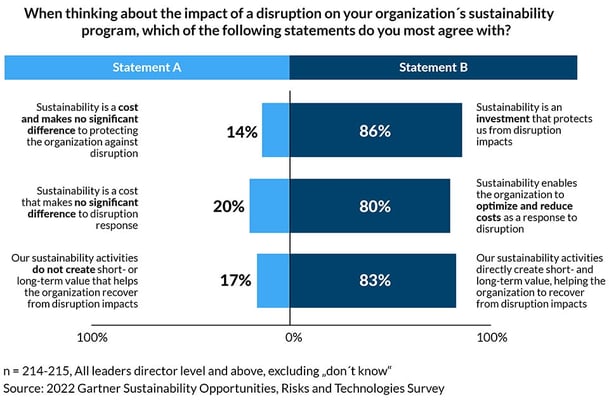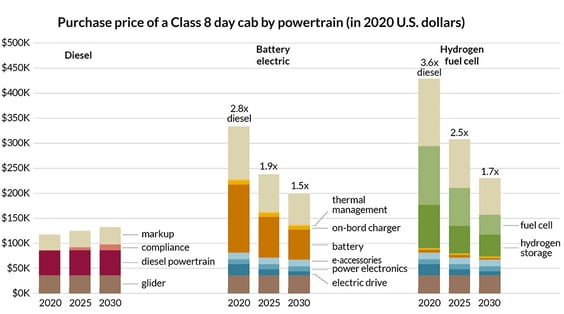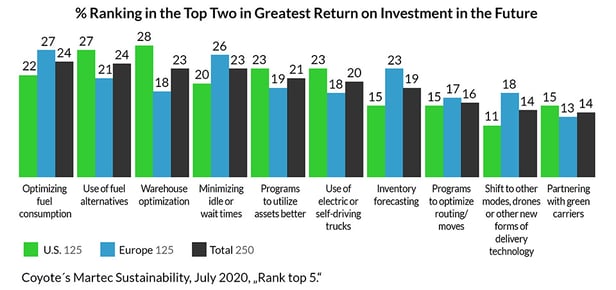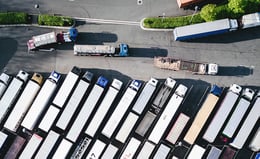How to Choose the Best Solution for Sustainable Transportation
Keith LaBotz - December 15, 2022

Supply chains face an array of challenges unlike anything seen in several decades. Despite unprecedented economic uncertainty and geopolitical risk, the bar of expectations is also higher: transition to a green business model while increasing profitability, agility, and customer satisfaction.
When expectations are unrealistic, a company is at risk, and logistics sustainability goals are particularly vulnerable to this problem. It’s more prevalent than most realize, so many sustainability plans are at risk of failing. Instead of blaming googly-eyed goal-setters, we need to understand why companies are pledging themselves to the impossible and what you can do to prevent it.
If there’s a culprit to blame for our overconfidence, it's probably Gordon Moore, who came up with Moore’s law. Decades of increasing microprocessor power have resulted in magical thinking and pulling rabbits out of a hat, the norm.
Digital supply chains reduce logistics risks to harmless colored bars in charts on a dashboard that we eliminate with a few mouse clicks. AI and robots that once disturbed us with their creepy behavior are now trusted pals that solve any problem that comes our way. No problem is too big for us now.
No fossil fuel and no viable alternatives? No problem.
Zero carbon? No problem.
Big problems if we trivialize risks, and that’s what many companies are doing regarding supply chain sustainability. While we can blame Moore's law for hyper-confidence, the messengers are often company executives, and it's a widespread problem.
Sustainability is Appealing, and That’s a Problem
Sustainability is an appealing proposition, so executives are eager to promote the topic. The stakes rise in the corporate echo chamber where everyone must outdo each other, the stakes rise, and these elevated commitments become someone else’s charter.
Sustainability is an unproven business model; transitioning to a new business model is risky, and economic recession increases these hazards. The result is sustainability promises with an extraordinarily high probability of failure.
 A recent Gartner survey revealed over 80% of business leaders believe a sustainable business model will reduce costs and increase resilience. They don’t explain how they arrived at such bullish conclusions, but anyone tasked with implementing them needs to assess whether they’re realistic before acting.
A recent Gartner survey revealed over 80% of business leaders believe a sustainable business model will reduce costs and increase resilience. They don’t explain how they arrived at such bullish conclusions, but anyone tasked with implementing them needs to assess whether they’re realistic before acting.
If there is any doubt overly ambitious sustainability goals are trouble, consider the repeated failures of every nation to meet climate commitments over the past seven years since the Paris Agreement in 2015. The disappointing results have more to do with unrealistic goals not aligned with business priorities rather than sacrificing more for the cause.
The top priority of healthy individuals and businesses is sustaining their health, and it’s a prerequisite for contributing effectively. We are responsible for every choice we support for supply chain sustainability, including following storybook commitments and plans.
You can help your company succeed by ensuring solutions for sustainable transportation adhere to fundamental principles that create more robust business processes.
Principles for Sustainability Success
The basic principles for sustainability success parallel self-care: a company’s business enterprise must be healthy before it can benefit its supply chain and the larger global community. Translating this into a set of practical rules for building a sustainable business process:
- A healthy supply chain is profitable.
- A healthy supply chain evolves toward increasing value and resilience.
- A supply chain risk is anything that threatens supply chain health.
- A sustainable solution sustains supply chain health by reducing risks.
For example, an EV semi costs nearly 300% more than a new diesel tractor. The driving range and service availability for diesel are virtually unlimited, while the best coverage from an EV is only 500 miles before removing the vehicle from service for recharging. An EV is also restricted to limited geographies and routes that keep it within range of charging stations.
 Source: International Council on Clean Transportation
Source: International Council on Clean Transportation
Few companies can afford the initial price of an EV, and even fewer can operate competitively with the operating constraints. While using an EV emits zero carbon, it does not sustain supply chain health in many use scenarios, so it is not a sustainable solution for those scenarios.
Why Intermodal is the Best Solution for Starting a Sustainable Transportation Strategy

Choosing the best solution for sustainable transportation begins with setting achievable goals that improve the health of your company's business enterprise. The elevated risks of transitioning to a sustainable business model favor lower-risk transportation options for a starting point.
The above chart from Coyote’s Martec Sustainability Survey shows how ROI varies for sustainable logistics solutions. Higher ROI and risk generally correlate, meaning that the three least risky solutions are:
- Programs to optimize routing/ moves.
- Shift to other modes, drones, or new forms of delivery technology.
- Partnering with green carriers.
Intermodal rail transportation fits the bill, and a previous post about a leading kitchen manufacturer provides a use case where the flexis VRS solution optimized intermodal rail to reduce a shipper's fleet size by 66%. With the right logistics software, managing intermodal rail services is effortless, and it significantly improves supply chain health while reducing carbon emissions.
Let’s briefly consider what your company can expect from intermodal rail transportation as a starting point for a sustainable transport strategy.
Rail Reduces Emissions
Converting truckload freight to intermodal reduces CO2 emissions by an average of 30%, and the reason is simple: trains use a single power unit to pull multiple trailers. A train fully loaded with double-stacked containers can transport 280 trucks.
Advances in battery-powered locomotives may eliminate CO2 from rail transport, but this is still years away for long-range transport. Fossil fuels will remain the preferred energy source if no significant breakthrough exists.
Intermodal is Best for Long-Haul Freight
The idea is to maximize rail miles and minimize drayage miles to reduce cost and emissions. Some guidelines for whether or not freight is a candidate for intermodal rail.
- Delivery exceeds 600 miles (965 kilometers).
- Freight typically ships in a 53-foot dry trailer.
- Origin and destination are both within 100 miles of intermodal ramps.
Rail Increases Transit Time
Intermodal transit usually adds one or two days compared to a full truckload. Using a solution like flexis SCM Transportation Planning and Scheduling can coordinate shipping with rail schedules, allowing earlier shipment dates to offset this difference, meeting delivery commitments.
Conclusion
Transitioning to a sustainable business model is risky, and following principles for supply chain health will ensure realistic goals that lead to success. Lower-risk sustainable transportation like intermodal rail offers an excellent starting point, and flexis provides all the capabilities discussed to support this improvement with minimal effort.
If you want to learn more get your Guide to Logistics 4.0
In this Guide you will learn:
-
Why a strategic process in transportation planning is a top priority for digitalization
-
What megatrends will increase supply chain volatility
-
How to manage it
Want to learn more about Multimodal Transportation?
Download our presentation and learn:
-
How can transports be planned quickly and yet flexible so that CO2 savings are verifiable?
-
How do you make optimal use of a multimodal transport network that maintains supply in both the short and long term?
-
How can you more easily realize a modal shift when disruptions occur? And how do you keep a grip on your CO2 emissions in doing so?
flexis and BigMile present a Use Case of a modal shift and show that network optimizations and sustainability often go hand in hand.
LATEST POSTS
- Understand Circular Economy in The Manufacturing Industry
- How Can Industry 4.0 IT Integration Be Achieved Smoothly?
- The Significance of Order Sequencing in Discrete Manufacturing
- How to improve your Supply Chain Management: The Power of Control Towers
- Optimizing Human Resource Scheduling in Manufacturing: A Technological Approach




